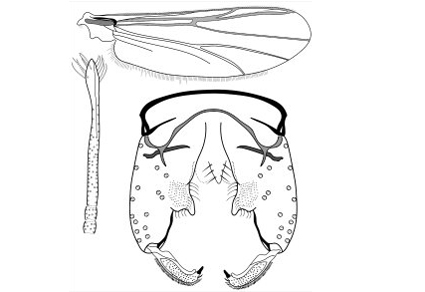Abstract
In this study, we describe Paracricotopus davoodi sp. nov., a new Orthocladiinae, and report on eight new faunistic records from Iran, further extending their distribution within the Palearctic realm. Along with describing a new species, we provide a key for the adult males and immatures of the genus Paracricotopus Brundin, 1956. We conducted this study as part of our ongoing investigation of the Chironomidae biodiversity in western Iran, where we aim to database new faunistic records and new taxa in the freshwaters of the Zagros Mountains. The studied freshwater, Shalmash Falls, is part of the main channel of the Little Zab River tributary that originates from the natural springs and glacier-fed runoffs of the Zagros Mountains. The Shalmash Falls is considered a natural wonder of western Iran and has ecotourism importance.
References
- Albu, P. (1968) Chironomide din Carpatii romans (III). Studii Si Cercetari Biologie Seria Zoologie, 20, 455–465.
- Amini, A. (2017) Evaluation of inter-basin water transfer projects based on development potential of the donor basin at Sirwan Basin, Kurdistan, Iran. Watershed Engineering and Management, 9, 217–228. https://doi.org/10.22092/ijwmse.2017.109727
- Andersen T., Sæther O.A., Cranston, P.S. & Epler J.H. (2013) The larvae of Orthocladiinae (Diptera: Chironomidae) of the Holarctic Region-Keys and diagnoses. In: Andersen, T., Cranston, P.S. & Epler, J.H. (Eds.) Chironomidae of the Holarctic Region. Keys and diagnoses – Larvae. Insects Systematics and Evolution Supplement 66. Lund, Sweden, pp 189–385.
- Bhattacharyay, S. & Chaudhuri, P.K. (1988) Nanocladius (Nanocladius) insulatus sp. nov., a montane orthoclad midge from India (Diptera: Chironomidae). Burdwan University Journal of Science, 4–5, 60–62 + 1 (unpaginated figure page).
- Brundin, L. (1947) Zur Kenntnis der schwedischen Chironomiden. Arkiv för zoologi, 39, 1–95.
- Brundin, L. (1956) Zur Systematik der Orthocladiinae (Dipt., Chironomidae). Report from the Institute of Freshwater Research, Drottningholm, 37, 5–185.
- Caldwell, B.A. (1985) Paracricotopus millrockensis, a new species of Orthocladiinae (Diptera: Chironomidae) from the southeastern United States. Brimleyana, 11, 161–168.
- Chaudhuri, P.K. & Som, D.K. (1999) Paracricotopus missilus sp.n., a new orthoclad species from Darjeeling Himalayas of India (Diptera: Chironomidae). Russian Entomological Journal, 7, 51–56.
- Hazra, N., Saha, G.K. & Chaudhuri, P.K. (2002) Records of Orthoclad species from the Darjeeling–Sikkim Himalayas of India (Diptera: Chironomidae), with notes on their ecology. Hydrobiologia, 474, 41–55. https://doi.org/10.1023/A:1016511702944
- Inkscape Project (2022) Inkscape. Available from: https://inkscape.org (accessed 28 February 2023)
- Jafari, A. (1989) Identity Card of Natural Geography of Iran. 3rd Edition. Gitashenasi Publications, Tehran, 88 pp. [in Persian]
- Khezri, S. (2000) Natural Geography of Kurdistan Mokrian, First Edition. Nagous Publications, Tehran, 248 pp. [in Persian]
- Langton, P.H. & Pinder, L.C.V. (2007) Keys to the adult male Chironomidae of Britain and Ireland. Vols. 1 & 2. Freshwater Biological Association (FBA), The Ferry House, Far Sawrey, Ambleside, Cumbria, 168 + 239 pp.
- Mohammadi, H., Ghaderi, E., Ghorbani, F., Mansouri, A. & Namayandeh, A. (2021a) Chironomidae (Diptera: Insecta) from Sirwan River watershed of Kurdistan (Iran) with new faunistic records for Iran and range extensions for the Palearctic region. Biologia, 76, 1227–1253. https://doi.org/10.2478/s11756-020-00635-3
- Mohammadi, H., Ghobari, H., Ghaderi, E., Fatehi, F., Salehi, H. & Namayandeh, A. (2021b) Chironomidae (Diptera: Insecta) of Qeshlagh River, Kurdistan: DNA and morphology reveal new genus, species, and faunistic records for Iran. Journal of Zoological Systematics and Evolutionary Research, 59, 1416–1437. https://doi.org/10.1111/jzs.12521
- Moller Pillot, H.K.M. (2013) Chironomidae larvae of the Netherlands and adjacent lowlands. III. Biology and ecology of the aquatic Orthocladiinae – Prodiamesinae – Diamesinae – Buchonomyiinae –Podonominae – Telmatogetoninae. KNNV Publications, Zeist, Netherlands, 314 pp.
- Niitsuma, H. (1990) Paracricotopus (Diptera: Chironomidae) from Japan, with description of a new species. Japanese Journal of Entomology, 58, 95–107.
- Salari, M. (2020) Evaluation of geomorphosites and analysis of their strengths and weaknesses using GAM and M-GAM models (Case study: Sardasht city). Natural hazard management, 6, 185–204. https://doi.org/10.22059/jhsci.2019.283578.481
- Sæther, O.A. (1980a) Glossary of chironomid morphology terminology (Diptera: Chironomidae). Entomologica scandinavica Supplement, 14, 5–51
- Sæther, O.A. (1980b) The females and immatures of Paracricotopus Thienemann and Harnisch, 1932, with the description of a new species (Diptera: Chironomidae). Aquatic Insects, 2, 129–145. https://doi.org/10.1080/01650428009361018
- Sasa, M. & Okazawa, T. (1992) Part 2. Studies on chironomid midges (Yusurika) of Toga Mura, Toyama. The subfamily Orthocladiinae. In: Some characteristics of nature conservation within the chief rivers in Toyama Prefecture (The upper reach of Kurobe River. Research Report of Toyama Prefecture Environmental Pollution Research Center, 1992, pp. 92–204.
- Sasa, M., Kawai, K. & Ueno, R. (1988) Studies on the chironomid midges of the Oyabe River, Toyama, Japan. In: Some characteristics of nature conservation within the chief rivers in Toyama Prefecture (The upper reach of Oyabe River). Research Report of Toyama Prefectural Environmental Pollution Research Center, 1988, pp. 26–85.
- Schmid, P.E. (1993) A key to the larval Chironomidae and their instars from Austrian Danube region streams and rivers. Part 1: Diamesinae, Prodiamesinae and Orthocladiinae. Federal Institute for Water Quality, Vienna, Wasser und Abwasser, Supplement, 3⁄93, 514 pp.
- Steiner, J.W. (1983) Paracricotopus mozleyi n. sp. from Georgia, U.S.A. (Diptera: Chironomidae) In: Roback, S.S. (Ed.), Proceedings of the 8th International Symposium of Chironomidae, Jacksonville, Florida, 25–28 July 1982. Memoirs of the American Entomological Society, No. 34, pp. 329–335.


